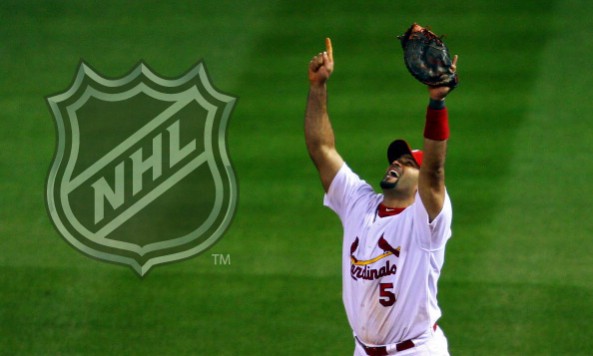Allow me to cross sports lines for a moment. Earlier this morning, it was reported through multiple media sites that the best free agent in major league baseball this offseason, first baseman Albert Pujols, was signed by the Anaheim Angels (lets not get technical over a name Los Angeles county residents) for $250 million over a span of ten years. The sports world hasn’t seen a contract like this since Alex Rodriguez signed a ten-year deal in 2000 for $252 million and then renegotiated after opting out in 2007 for another $275 million. The numbers alone are mind boggling for an athlete – especially in baseball, when you only have to be successful 30-35% of time at the plate to be considered an All-Star.
When the news broke, twitter began to pour out absurd statistical evidence to boggle our minds. Reporters such as Darren Rovell spewed out average household incomes, World Series odds, and anything that could garner a reaction from the masses. The rest of my hockey timeline began chime in with the humor train, often citing religious punchlines. And while we can all “ooo” and “ahh” at the numbers, has anyone really thought how much of a mess baseball really is? What if the NHL was like that? Could the fans take the wild west approach to hockey?
If the NHL didn’t have a salary cap, imagine the potential mess the league would be in:
- Any player worth their weight would at least have a brief career stop in Toronto.
- There would only be one team in New York. Their top line would Patrick Marleau, Brad Richards, and Marion Garborik. Don’t forget that they’d have Shea Weber and Anton Volchenkov roam in their defensive zone.
- Edmonton would be the official farm team of the league.
- There would be free phones for all players who sign with the Kansas City Penguins.
- Dale Tallon would have to mortgage the entire state of Florida to put a roster together for the Panthers.
- Alexander Ovechkin would opt out of his contract only to sign an eight-year $160 million contract with the Montreal Canadiens.
- Clubs would spend 85-90% of total revenues on player salaries. The desperate teams would purposely go in the red for a chance at mediocrity.
- If you think the Leaf cup drought is bad, Winnipeg would demolish that record given the proper time.
Do I need to continue?
I, for one, am very thankful that the National Hockey League implemented a salary cap after the 2004-2005 lockout. The beauty of it all is that when it comes to player salaries, no single player can be paid more than 20% of the salary cap. Once a player agrees to the contract, the terms are set. The contract cannot increase or decrease due an adjusted salary cap. The only way a player can leave his contract is if the club decides to buy out the contract, which will negatively affect the team’s cap room. Simply put, each club has employees that strictly work on dealing with how to put a team together while maximizing the salary cap room. Players cannot command mammoth contracts that require a quarter of a billion dollars.
The ends are starting to unravel however. Since the NHL and the NHLPA signed the latest CBA, general managers have tried to bend the rules as much as they could. From front loaded contracts to adding extra years at the end, general managers have tried to use as many smoke and mirror tactics as they could. These players have benefited the most (Side note: Can anyone vouch for Flyers GM Paul Holmgren? Does he know what he gets himself into?):
- Alex Ovechkin (Capitals) – 13 years – $124M
- Ilya Kovalchuck (Devils) – 15 years – $100M
- Roberto Luongo (Canucks) – 12 years – $64M
- Mike Richards (Kings via Flyers) – 12 years – $69M
- Jeff Carter (Blue Jackets via Flyers) – 11 years – $58M
- Rick DiPietro (Islanders) – 15 years – $67.5M
- Christian Ehrhoff (Sabres) – 10 years – $40M
- llya Bryzgalov (Flyers) – 9 years – $51M
Ownership groups are likely to squash any wiggle room that is developing due to the fact that the current NHL CBA will end after the 2011-2012 season. The NHL Players Association and the league will squabble over player salaries, luxury taxes, and performance bonuses (amongst many other things). The drawn out contracts that you see listed above will become a hot button issue but I doubt that any current restrictions are lifted in favor of the players. Whenever a new agreement is signed, the salary cap will still be in place and there will still be general managers trying to work their way around it.
The Salary Cap is and will always be a friend to the National Hockey League. It may not a perfect system, but it does more good than bad. Hopefully in my lifetime, I will never see a moment where an NHL player can follow in the footsteps of Albert Pujols. Anything put in front of baseball players these days are quite alarming. Oddly enough, I can’t find fault with Mr. Pujols. If someone is insane enough to give you $250M, are you really to blame? But in the end, I’m just a jester talking about the King’s feast. Nothing new here.

